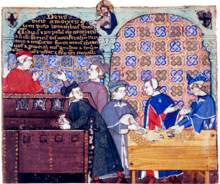
A counting house, or counting room, was traditionally an office in which the financial books of a business were kept. It was also the place that the business received appointments and correspondence relating to demands for payment.
Originating in Italy, the counting house was a central feature of commerce in the high Middle Ages and afterward. Calculations were typically quantified through the use of a counting board where the process could be spectated by interested persons. As technology developed and new practices emerged, particularly the adoption of Arabic numerals in financial record-keeping, use of the counting board became obsolete.
As the use of counting houses spread in the 19th century, so did their reputation as being often uncomfortable and dreary places to work. This was most famously exemplified in Charles Dickens A Christmas Carol, where the underpaid Bob Cratchit spends his days toiling in the employ of Ebenezer Scrooge.
See also
- Accounts payable
- Count room, a secure room for counting cash
- Exchequer
- Factory (trading post), a fortified settlement for the counting houses of overseas merchants
References
- Nelson, Richard (1902). Commercial and Counting-House Arithmetic. p. 205.
- Cross v. Smith, 1 M. & Selw., 545 (KB 13 May 1813) ("The counting-house is the place where all appointments respecting the joint business, and all notices should be addressed, and it is the duty of the merchant to take care that a proper person be in attendance.").
- Oliver, Jack (1997). "Calculations in Medieval Europe". Mathematics in School. 26 (3): 12–14. ISSN 0305-7259.
- Anderson, Gregory (1976). Victorian Clerks.
This accounting-related article is a stub. You can help Misplaced Pages by expanding it. |